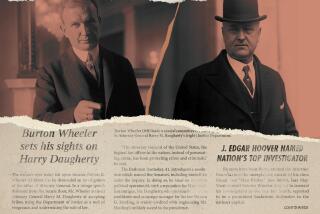Pressure, Errors by Both Sides Led to Ruby Ridge Siege
WASHINGTON â Three years later, with the eagle-like vision of hindsight, the violent confrontation at Ruby Ridge looks like nothing so much as a tragedy that need never have happened.
For all the charges and countercharges from both sides, the evidence emerging from three weeks of Senate hearings suggests that Randy Weaver and a small army of federal agents lumbered into deadly conflict more by accident than design.
Each side was spurred on by internal pressures. Each had created overblown images of the other. And each believed--and still believes--that it was forced by the other into confrontation and the outbursts of gunfire that claimed the lives of a deputy U.S. marshal, a 14-year-old boy and his mother.
For their part, Weaver and his wife had plunged so deeply into the fogs of white separatism, anti-government conspiracy theories and religious militancy that they faced the outside world with violent rhetoric and aggressive, threatening defiance.
Their isolated homestead beside Ruby Ridge in the mountains of northern Idaho bristled with guns. And Weaver, holed up with his family, openly defied a federal court order to appear on weapons charges and issued bellicose warnings against agents trying to arrest him.
At the same time, the actions of federal law enforcement agencies and the court at several stages of the protracted affair were shaped not purely by the actions of the Weavers but by the officialsâ own internal pressures and attitudes.
The result was distortions and exaggerations in the federal agentsâ view of the situation they faced, which played a role in tipping the case toward violence.
âItâs clear that the people involved had some correct information, some hazy information, some information that was partly true and some that was outright false,â Sen. Fred Thompson (R-Tenn.), a member of the Senate Judiciary Committeeâs subcommittee on terrorism that conducted the hearings, told federal officials.
For example, the Treasury Departmentâs Bureau of Alcohol, Tobacco and Firearms once classified Weaver as among the nationâs âmajor firearms suppliersâ and listed him as having a history of criminal violations, although he had no record of illegal activity other than selling two sawed-off shotguns to an undercover ATF operative.
Testimony before the Senate panel and in earlier legal proceedings suggests that ATF agents had tried to turn Weaver into an informant against other militants--and cracked down hard when he refused to cooperate.
âIt seems to me you were really looking at Mr. Weaver as an informant rather than a major supplier of guns,â subcommittee chairman Sen. Arlen Specter (R-Pa.) told ATF officials who testified about the case. The ATF undercover operative who bought illegal shotguns from Weaver acknowledged to senators that he had failed to tape-record what had been alleged to be Weaverâs most incriminating statements and thus had no corroboration.
Moreover, when Weaver failed to appear for a 1991 court hearing on the weapons charge and then publicly vowed not to be taken, the U.S. Marshals Service assigned his case a level of attention and resources far higher than it usually assigns to offenses, such as those with which Weaver was charged.
Again, the reasons seemed only partly related to Weaverâs actions. The ATF, according to Senate testimony, told the marshals service that Weaver was not only involved with illegal guns but also was suspected in a series of Montana bank robberies--an assertion not based on fact.
Questioned about this error by members of the subcommittee, the director of the ATF called it âinexcusable.â
âA person should not be listed as a suspect unless [he] actually [is] a suspect,â ATF Director John W. Magaw said firmly.
Exactly why the incorrect information was given to the marshals service was never explained, but it clearly contributed to the agencyâs inflated perception of Weaver as a major criminal and dangerous fugitive. That, in turn, helped shape the way they approached him.
Moreover, whereas the failure of a defendant to appear in court in a seemingly routine weapons case might not be a front-burner issue in many jurisdictions, it was so in Idaho--and the federal judge handling the case leaned hard on the marshals to bring Weaver in.
Aggravating the situation was another bit of misinformation--this one a simple bureaucratic mistake. Although Weaver had an initial trial date of Feb. 19, 1991, his defenders contend he failed to show up after receiving a federal probation office letter that incorrectly said his trial would start a month later--on March 20, 1991.
Between that time and August, 1992, when the bloody siege occurred, positions on both sides hardened as ATF and marshals service officials sought unsuccessfully to negotiate for Weaverâs peaceful surrender.
Tacitly acknowledging that the government contributed to the tragedy while insisting that it was admitting no wrongdoing, the Justice Department last month agreed to pay Weaver and his three daughters $3.1 million to settle a wrongful-death lawsuit he had brought against the government for the shooting deaths of his son, Sammy, and his wife, Vicki.
But Weaver, now 47, also bears heavy responsibility for the tragedy visited on his family and that of Deputy Marshal William Degan, a decorated officer who was fatally wounded in an initial confrontation near the Weaver cabin.
Weaver, the subcommitteeâs first witness earlier this month, acknowledged that âI am not without fault in this matter.â He went on to say that, âif I had it to do over again, knowing what I know now . . . I would come down from the mountain for the court appearance.â
Weaver and a friend, Kevin Harris, were cleared of murder charges in 1993 resulting from Deganâs death, and Weaver was acquitted of the firearms charges. A jury convicted him only of refusing to surrender for trial at the earlier date.
It was Weaverâs hostility toward authorities that set the stage for the ill-fated confrontation.
A man who advocated violence, Weaver held racist views, including a belief in âseparation of the races.â Some neighbors testified that he was a dangerous man, had fired gunshots at their homes and had vowed to die fighting if federal officers invaded his property.
Despite ample evidence that federal marshals had made repeated phone calls and visits to his cabin as early as March, 1992--and later made their demands by loudspeaker--Weaver insisted in his Senate testimony that in âno wayâ had he been asked to surrender before friends escorted him from his home nine days after his wifeâs death.
Aside from loss of lives, the massive outlay of resources involved in prosecuting such a low-level case stunned some senators. Sen. Patrick J. Leahy (D-Vt.) said that he had trouble understanding âmillions and millions of dollars spent. Careers are being ruined . . . and all this comes from selling two sawed-off shotguns.â
Weeks before the siege began, surveillance cameras were installed on ridges facing the small cabin, and aerial photographs were made of the property. Helicopter overflights were ordered, and dozens of deputy marshals and other law enforcement officers maintained posts around the clock.
More to Read
Sign up for Essential California
The most important California stories and recommendations in your inbox every morning.
You may occasionally receive promotional content from the Los Angeles Times.










